temperature FIAT SCUDO 2014 Owner handbook (in English)
[x] Cancel search | Manufacturer: FIAT, Model Year: 2014, Model line: SCUDO, Model: FIAT SCUDO 2014Pages: 227, PDF Size: 4.45 MB
Page 100 of 227
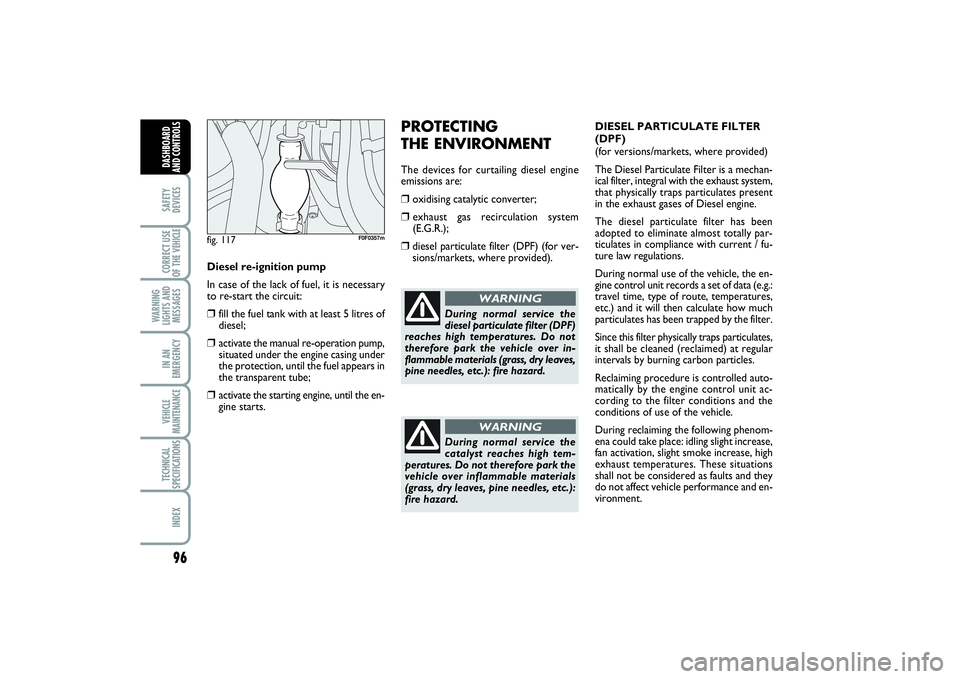
96SAFETY
DEVICESCORRECT USE
OF THE VEHICLE
WARNING
LIGHTS AND
MESSAGESIN AN
EMERGENCYVEHICLE
MAINTENANCETECHNICAL
SPECIFICATIONSINDEXDASHBOARD
AND CONTROLS
DIESEL PARTICULATE FILTER
(DPF)
(for versions/markets, where provided)
The Diesel Particulate Filter is a mechan-
ical filter, integral with the exhaust system,
that physically traps particulates present
in the exhaust gases of Diesel engine.
The diesel particulate filter has been
adopted to eliminate almost totally par-
ticulates in compliance with current / fu-
ture law regulations.
During normal use of the vehicle, the en-
gine control unit records a set of data (e.g.:
travel time, type of route, temperatures,
etc.) and it will then calculate how much
particulates has been trapped by the filter.
Since this filter physically traps particulates,
it shall be cleaned (reclaimed) at regular
intervals by burning carbon particles.
Reclaiming procedure is controlled auto-
matically by the engine control unit ac-
cording to the filter conditions and the
conditions of use of the vehicle.
During reclaiming the following phenom-
ena could take place: idling slight increase,
fan activation, slight smoke increase, high
exhaust temperatures. These situations
shall not be considered as faults and they
do not affect vehicle performance and en-
vironment.
During normal service the
diesel particulate filter (DPF)
reaches high temperatures. Do not
therefore park the vehicle over in-
flammable materials (grass, dry leaves,
pine needles, etc.): fire hazard.
WARNING
During normal service the
catalyst reaches high tem-
peratures. Do not therefore park the
vehicle over inflammable materials
(grass, dry leaves, pine needles, etc.):
fire hazard.
WARNING
PROTECTING
THE ENVIRONMENTThe devices for curtailing diesel engine
emissions are:❒
oxidising catalytic converter;
❒
exhaust gas recirculation system
(E.G.R.);
❒
diesel particulate filter (DPF) (for ver-
sions/markets, where provided).
Diesel re-ignition pump
In case of the lack of fuel, it is necessary
to re-start the circuit:
❒
fill the fuel tank with at least 5 litres of
diesel;
❒
activate the manual re-operation pump,
situated under the engine casing under
the protection, until the fuel appears in
the transparent tube;
❒
activate the starting engine, until the en-
gine starts.
fig. 117
F0F0357m
083-096 SCUDO LUM GB 19/11/13 13.07 Pagina 96
Page 125 of 227
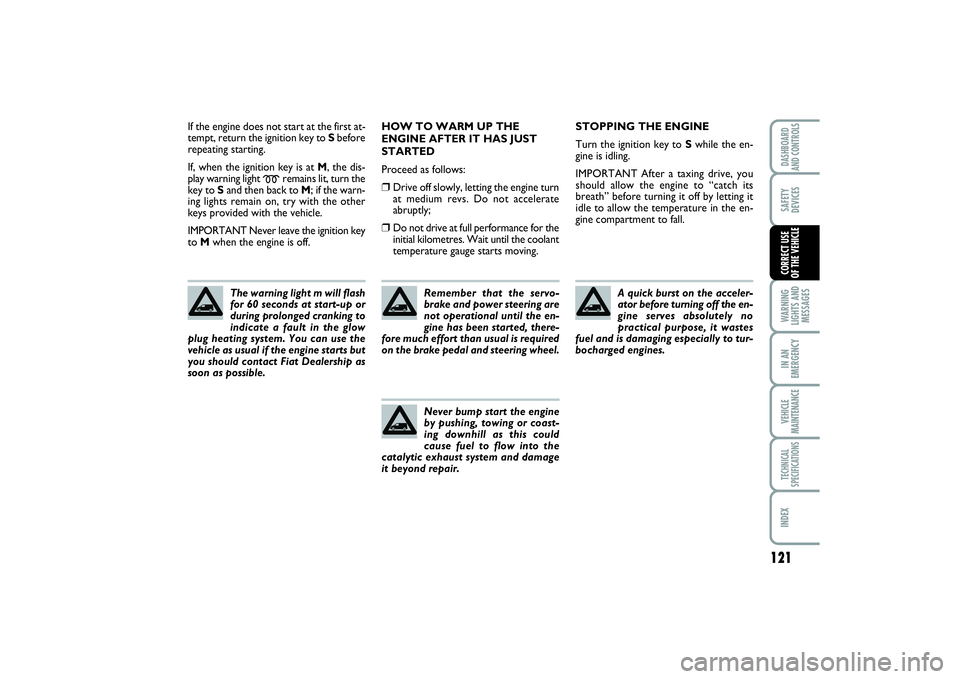
121
WARNING
LIGHTS AND
MESSAGESIN AN
EMERGENCYVEHICLE
MAINTENANCETECHNICAL
SPECIFICATIONSINDEXDASHBOARD
AND CONTROLSSAFETY
DEVICESCORRECT USE
OF THE VEHICLE
If the engine does not start at the first at-
tempt, return the ignition key to Sbefore
repeating starting.
If, when the ignition key is at M, the dis-
play warning light
m
remains lit, turn the
key to Sand then back to M; if the warn-
ing lights remain on, try with the other
keys provided with the vehicle.
IMPORTANT Never leave the ignition key
to Mwhen the engine is off.
The warning light m will flash
for 60 seconds at start-up or
during prolonged cranking to
indicate a fault in the glow
plug heating system. You can use the
vehicle as usual if the engine starts but
you should contact Fiat Dealership as
soon as possible.
HOW TO WARM UP THE
ENGINE AFTER IT HAS JUST
STARTED
Proceed as follows:❒
Drive off slowly, letting the engine turn
at medium revs. Do not accelerate
abruptly;
❒
Do not drive at full performance for the
initial kilometres. Wait until the coolant
temperature gauge starts moving.
Remember that the servo-
brake and power steering are
not operational until the en-
gine has been started, there-
fore much effort than usual is required
on the brake pedal and steering wheel.
Never bump start the engine
by pushing, towing or coast-
ing downhill as this could
cause fuel to flow into the
catalytic exhaust system and damage
it beyond repair.
STOPPING THE ENGINE
Turn the ignition key to Swhile the en-
gine is idling.
IMPORTANT After a taxing drive, you
should allow the engine to “catch its
breath” before turning it off by letting it
idle to allow the temperature in the en-
gine compartment to fall.
A quick burst on the acceler-
ator before turning off the en-
gine serves absolutely no
practical purpose, it wastes
fuel and is damaging especially to tur-
bocharged engines.
119-128 SCUDO LUM GB 18/11/13 14.26 Pagina 121
Page 126 of 227
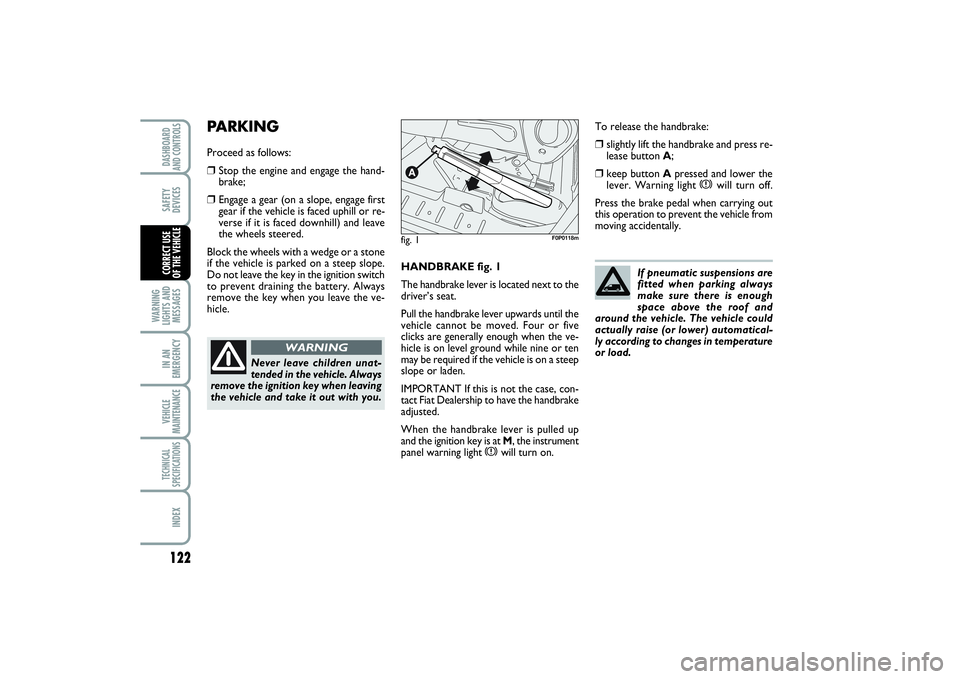
122WARNING
LIGHTS AND
MESSAGESIN AN
EMERGENCYVEHICLE
MAINTENANCETECHNICAL
SPECIFICATIONSINDEXDASHBOARD
AND CONTROLSSAFETY
DEVICESCORRECT USE
OF THE VEHICLE
HANDBRAKE fig. 1
The handbrake lever is located next to the
driver’s seat.
Pull the handbrake lever upwards until the
vehicle cannot be moved. Four or five
clicks are generally enough when the ve-
hicle is on level ground while nine or ten
may be required if the vehicle is on a steep
slope or laden.
IMPORTANT If this is not the case, con-
tact Fiat Dealership to have the handbrake
adjusted.
When the handbrake lever is pulled up
and the ignition key is at M, the instrument
panel warning light
x
will turn on.
PARKINGProceed as follows:❒
Stop the engine and engage the hand-
brake;
❒
Engage a gear (on a slope, engage first
gear if the vehicle is faced uphill or re-
verse if it is faced downhill) and leave
the wheels steered.
Block the wheels with a wedge or a stone
if the vehicle is parked on a steep slope.
Do not leave the key in the ignition switch
to prevent draining the battery. Always
remove the key when you leave the ve-
hicle.
Never leave children unat-
tended in the vehicle. Always
remove the ignition key when leaving
the vehicle and take it out with you.
WARNING
fig. 1
F0P0118m
To release the handbrake:❒
slightly lift the handbrake and press re-
lease button A;
❒
keep button Apressed and lower the
lever. Warning light
x
will turn off.
Press the brake pedal when carrying out
this operation to prevent the vehicle from
moving accidentally.
If pneumatic suspensions are
fitted when parking always
make sure there is enough
space above the roof and
around the vehicle. The vehicle could
actually raise (or lower) automatical-
ly according to changes in temperature
or load.
119-128 SCUDO LUM GB 18/11/13 14.26 Pagina 122
Page 128 of 227
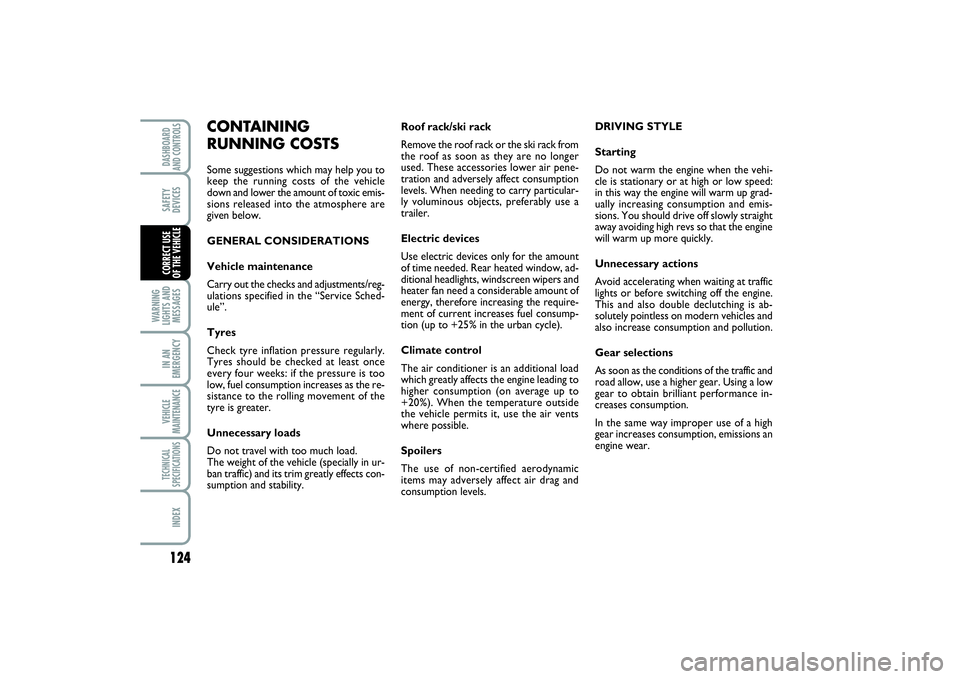
124WARNING
LIGHTS AND
MESSAGESIN AN
EMERGENCYVEHICLE
MAINTENANCETECHNICAL
SPECIFICATIONSINDEXDASHBOARD
AND CONTROLSSAFETY
DEVICESCORRECT USE
OF THE VEHICLE
Roof rack/ski rack
Remove the roof rack or the ski rack from
the roof as soon as they are no longer
used. These accessories lower air pene-
tration and adversely affect consumption
levels. When needing to carry particular-
ly voluminous objects, preferably use a
trailer.
Electric devices
Use electric devices only for the amount
of time needed. Rear heated window, ad-
ditional headlights, windscreen wipers and
heater fan need a considerable amount of
energy, therefore increasing the require-
ment of current increases fuel consump-
tion (up to +25% in the urban cycle).
Climate control
The air conditioner is an additional load
which greatly affects the engine leading to
higher consumption (on average up to
+20%). When the temperature outside
the vehicle permits it, use the air vents
where possible.
Spoilers
The use of non-certified aerodynamic
items may adversely affect air drag and
consumption levels.DRIVING STYLE
Starting
Do not warm the engine when the vehi-
cle is stationary or at high or low speed:
in this way the engine will warm up grad-
ually increasing consumption and emis-
sions. You should drive off slowly straight
away avoiding high revs so that the engine
will warm up more quickly.
Unnecessary actions
Avoid accelerating when waiting at traffic
lights or before switching off the engine.
This and also double declutching is ab-
solutely pointless on modern vehicles and
also increase consumption and pollution.
Gear selections
As soon as the conditions of the traffic and
road allow, use a higher gear. Using a low
gear to obtain brilliant performance in-
creases consumption.
In the same way improper use of a high
gear increases consumption, emissions an
engine wear.
CONTAINING
RUNNING COSTSSome suggestions which may help you to
keep the running costs of the vehicle
down and lower the amount of toxic emis-
sions released into the atmosphere are
given below.
GENERAL CONSIDERATIONS
Vehicle maintenance
Carry out the checks and adjustments/reg-
ulations specified in the “Service Sched-
ule”.
Tyres
Check tyre inflation pressure regularly.
Tyres should be checked at least once
every four weeks: if the pressure is too
low, fuel consumption increases as the re-
sistance to the rolling movement of the
tyre is greater.
Unnecessary loads
Do not travel with too much load.
The weight of the vehicle (specially in ur-
ban traffic) and its trim greatly effects con-
sumption and stability.
119-128 SCUDO LUM GB 18/11/13 14.26 Pagina 124
Page 129 of 227
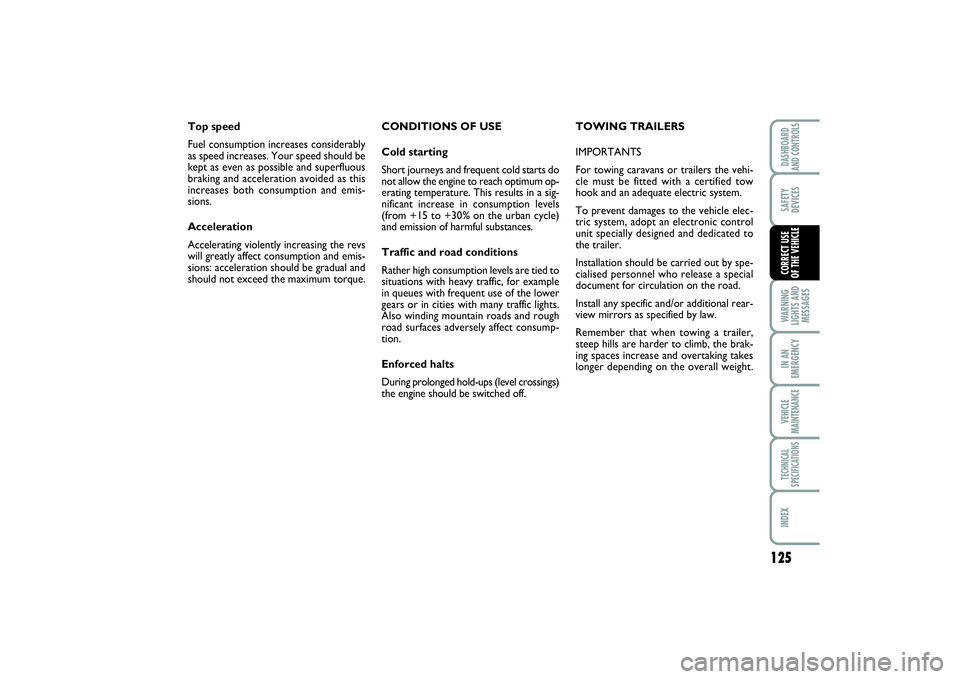
125
WARNING
LIGHTS AND
MESSAGESIN AN
EMERGENCYVEHICLE
MAINTENANCETECHNICAL
SPECIFICATIONSINDEXDASHBOARD
AND CONTROLSSAFETY
DEVICESCORRECT USE
OF THE VEHICLE
CONDITIONS OF USE
Cold starting
Short journeys and frequent cold starts do
not allow the engine to reach optimum op-
erating temperature. This results in a sig-
nificant increase in consumption levels
(from +15 to +30% on the urban cycle)
and emission of harmful substances.
Traffic and road conditions
Rather high consumption levels are tied to
situations with heavy traffic, for example
in queues with frequent use of the lower
gears or in cities with many traffic lights.
Also winding mountain roads and rough
road surfaces adversely affect consump-
tion.
Enforced halts
During prolonged hold-ups (level crossings)
the engine should be switched off. Top speed
Fuel consumption increases considerably
as speed increases. Your speed should be
kept as even as possible and superfluous
braking and acceleration avoided as this
increases both consumption and emis-
sions.
Acceleration
Accelerating violently increasing the revs
will greatly affect consumption and emis-
sions: acceleration should be gradual and
should not exceed the maximum torque.TOWING TRAILERS
IMPORTANTS
For towing caravans or trailers the vehi-
cle must be fitted with a certified tow
hook and an adequate electric system.
To prevent damages to the vehicle elec-
tric system, adopt an electronic control
unit specially designed and dedicated to
the trailer.
Installation should be carried out by spe-
cialised personnel who release a special
document for circulation on the road.
Install any specific and/or additional rear-
view mirrors as specified by law.
Remember that when towing a trailer,
steep hills are harder to climb, the brak-
ing spaces increase and overtaking takes
longer depending on the overall weight.
119-128 SCUDO LUM GB 18/11/13 14.26 Pagina 125
Page 133 of 227
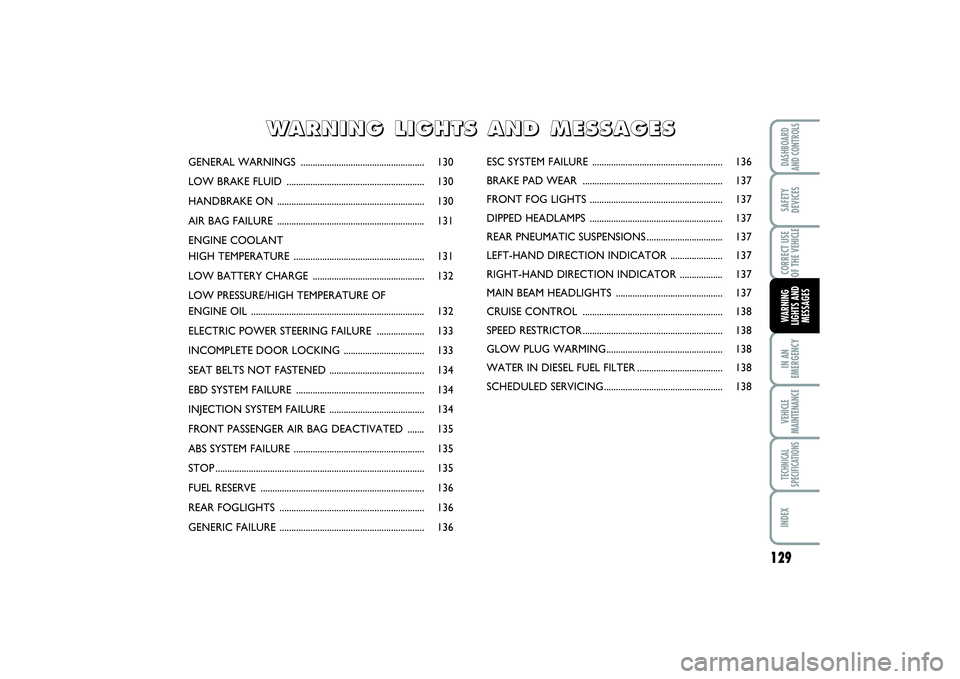
129
IN AN
EMERGENCYVEHICLE
MAINTENANCETECHNICAL
SPECIFICATIONSINDEXDASHBOARD
AND CONTROLSSAFETY
DEVICESCORRECT USE
OF THE VEHICLEWARNING
LIGHTS AND
MESSAGES
GENERAL WARNINGS .................................................... 130
LOW BRAKE FLUID .......................................................... 130
HANDBRAKE ON .............................................................. 130
AIR BAG FAILURE .............................................................. 131
ENGINE COOLANT
HIGH TEMPERATURE ....................................................... 131
LOW BATTERY CHARGE ............................................... 132
LOW PRESSURE/HIGH TEMPERATURE OF
ENGINE OIL ......................................................................... 132
ELECTRIC POWER STEERING FAILURE .................... 133
INCOMPLETE DOOR LOCKING .................................. 133
SEAT BELTS NOT FASTENED ........................................ 134
EBD SYSTEM FAILURE ...................................................... 134
INJECTION SYSTEM FAILURE ........................................ 134
FRONT PASSENGER AIR BAG DEACTIVATED ....... 135
ABS SYSTEM FAILURE ....................................................... 135
STOP ........................................................................................ 135
FUEL RESERVE ..................................................................... 136
REAR FOGLIGHTS ............................................................. 136
GENERIC FAILURE ............................................................. 136ESC SYSTEM FAILURE ....................................................... 136
BRAKE PAD WEAR ........................................................... 137
FRONT FOG LIGHTS ........................................................ 137
DIPPED HEADLAMPS ........................................................ 137
REAR PNEUMATIC SUSPENSIONS ................................ 137
LEFT-HAND DIRECTION INDICATOR ...................... 137
RIGHT-HAND DIRECTION INDICATOR .................. 137
MAIN BEAM HEADLIGHTS ............................................. 137
CRUISE CONTROL ........................................................... 138
SPEED RESTRICTOR ........................................................... 138
GLOW PLUG WARMING................................................. 138
WATER IN DIESEL FUEL FILTER .................................... 138
SCHEDULED SERVICING.................................................. 138
W W
A A
R R
N N
I I
N N
G G
L L
I I
G G
H H
T T
S S
A A
N N
D D
M M
E E
S S
S S
A A
G G
E E
S S
129-138 SCUDO LUM GB 18/11/13 14.25 Pagina 129
Page 135 of 227
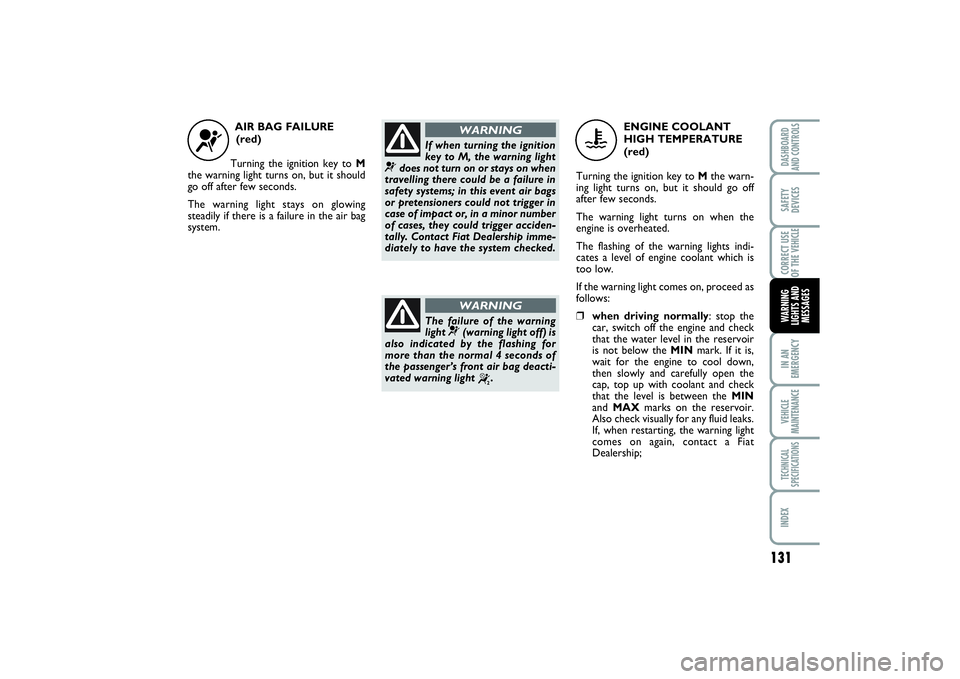
131
IN AN
EMERGENCYVEHICLE
MAINTENANCETECHNICAL
SPECIFICATIONSINDEXDASHBOARD
AND CONTROLSSAFETY
DEVICESCORRECT USE
OF THE VEHICLEWARNING
LIGHTS AND
MESSAGES
AIR BAG FAILURE
(red)
Turning the ignition key to M
the warning light turns on, but it should
go off after few seconds.
The warning light stays on glowing
steadily if there is a failure in the air bag
system.
¬
If when turning the ignition
key to M, the warning light
¬
does not turn on or stays on when
travelling there could be a failure in
safety systems; in this event air bags
or pretensioners could not trigger in
case of impact or, in a minor number
of cases, they could trigger acciden-
tally. Contact Fiat Dealership imme-
diately to have the system checked.
WARNING
The failure of the warning
light
¬
(warning light off) is
also indicated by the flashing for
more than the normal 4 seconds of
the passenger’s front air bag deacti-
vated warning light
“
.
WARNING
ENGINE COOLANT
HIGH TEMPERATURE
(red)
Turning the ignition key to Mthe warn-
ing light turns on, but it should go off
after few seconds.
The warning light turns on when the
engine is overheated.
The flashing of the warning lights indi-
cates a level of engine coolant which is
too low.
If the warning light comes on, proceed as
follows:
❒when driving normally: stop the
car, switch off the engine and check
that the water level in the reservoir
is not below the MINmark. If it is,
wait for the engine to cool down,
then slowly and carefully open the
cap, top up with coolant and check
that the level is between the MIN
and MAXmarks on the reservoir.
Also check visually for any fluid leaks.
If, when restarting, the warning light
comes on again, contact a Fiat
Dealership;
u
129-138 SCUDO LUM GB 18/11/13 14.25 Pagina 131
Page 136 of 227
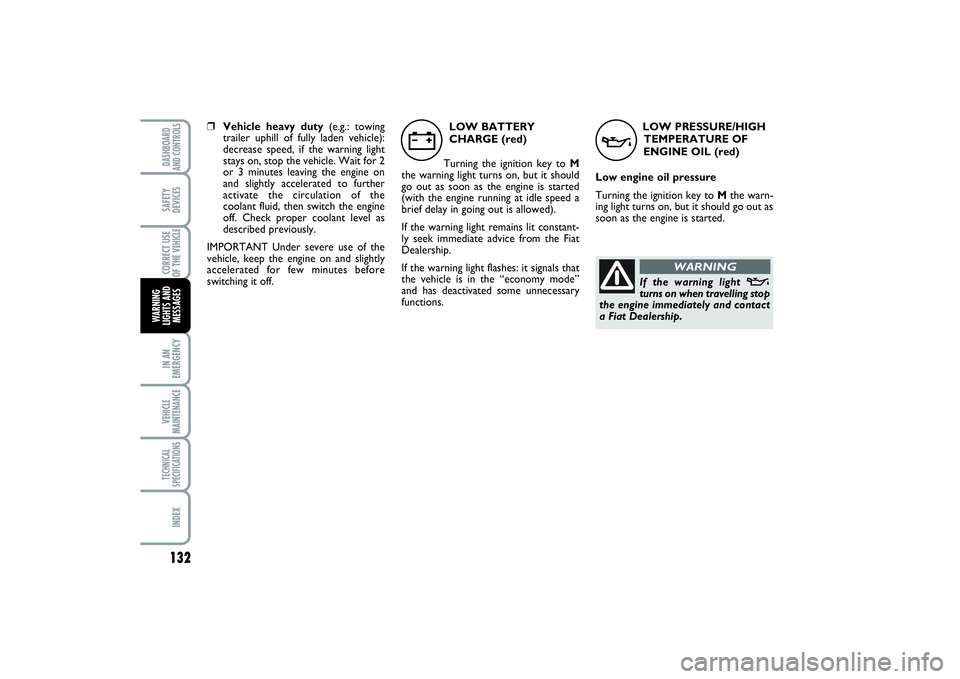
132IN AN
EMERGENCYVEHICLE
MAINTENANCETECHNICAL
SPECIFICATIONSINDEXDASHBOARD
AND CONTROLSSAFETY
DEVICESCORRECT USE
OF THE VEHICLE
WARNING
LIGHTS AND
MESSAGES
LOW PRESSURE/HIGH
TEMPERATURE OF
ENGINE OIL (red)
Low engine oil pressure
Turning the ignition key to Mthe warn-
ing light turns on, but it should go out as
soon as the engine is started.
v
If the warning light
v
turns on when travelling stop
the engine immediately and contact
a Fiat Dealership.
WARNING
❒Vehicle heavy duty(e.g.: towing
trailer uphill of fully laden vehicle):
decrease speed, if the warning light
stays on, stop the vehicle. Wait for 2
or 3 minutes leaving the engine on
and slightly accelerated to further
activate the circulation of the
coolant fluid, then switch the engine
off. Check proper coolant level as
described previously.
IMPORTANT Under severe use of the
vehicle, keep the engine on and slightly
accelerated for few minutes before
switching it off.LOW BATTERY
CHARGE (red)
Turning the ignition key to M
the warning light turns on, but it should
go out as soon as the engine is started
(with the engine running at idle speed a
brief delay in going out is allowed).
If the warning light remains lit constant-
ly seek immediate advice from the Fiat
Dealership.
If the warning light flashes: it signals that
the vehicle is in the “economy mode”
and has deactivated some unnecessary
functions.
w
129-138 SCUDO LUM GB 18/11/13 14.25 Pagina 132
Page 142 of 227
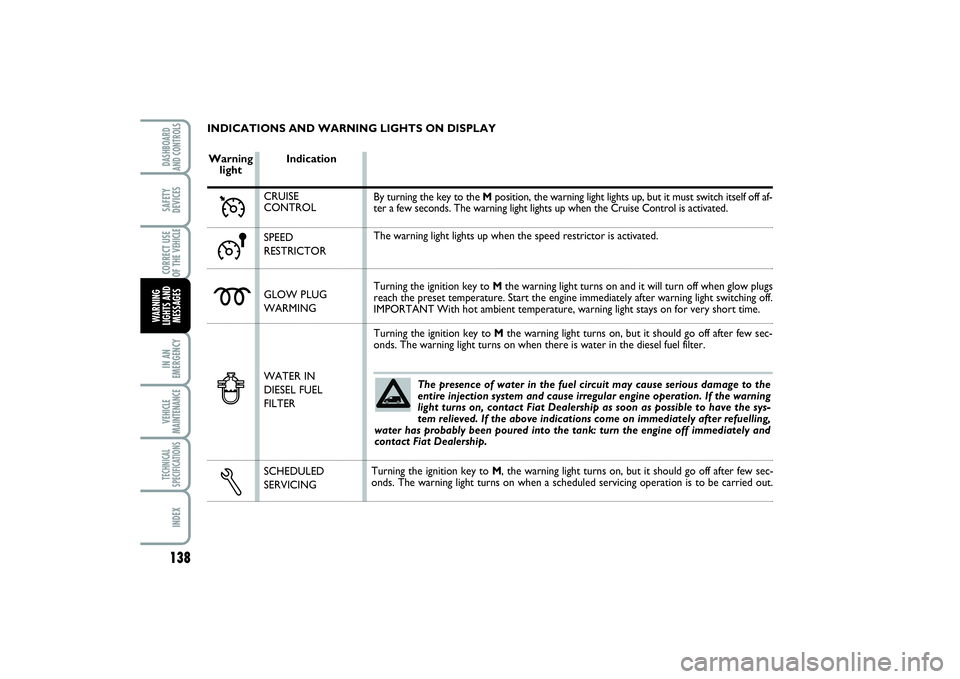
138IN AN
EMERGENCYVEHICLE
MAINTENANCETECHNICAL
SPECIFICATIONSINDEXDASHBOARD
AND CONTROLSSAFETY
DEVICESCORRECT USE
OF THE VEHICLE
WARNING
LIGHTS AND
MESSAGES
INDICATIONS AND WARNING LIGHTS ON DISPLAY
Indication
CRUISE
CONTROL
SPEED
RESTRICTOR
GLOW PLUG
WARMING
WATER IN
DIESEL FUEL
FILTER
SCHEDULED
SERVICING
Warning
light
By turning the key to the Mposition, the warning light lights up, but it must switch itself off af-
ter a few seconds. The warning light lights up when the Cruise Control is activated.
The warning light lights up when the speed restrictor is activated.
Turning the ignition key to Mthe warning light turns on and it will turn off when glow plugs
reach the preset temperature. Start the engine immediately after warning light switching off.
IMPORTANT With hot ambient temperature, warning light stays on for very short time.
Turning the ignition key to Mthe warning light turns on, but it should go off after few sec-
onds. The warning light turns on when there is water in the diesel fuel filter.m
The presence of water in the fuel circuit may cause serious damage to the
entire injection system and cause irregular engine operation. If the warning
light turns on, contact Fiat Dealership as soon as possible to have the sys-
tem relieved. If the above indications come on immediately after refuelling,
water has probably been poured into the tank: turn the engine off immediately and
contact Fiat Dealership.
Turning the ignition key to M, the warning light turns on, but it should go off after few sec-
onds. The warning light turns on when a scheduled servicing operation is to be carried out.
܃≈Δ
129-138 SCUDO LUM GB 18/11/13 14.25 Pagina 138
Page 172 of 227

168WARNING
LIGHTS AND
MESSAGESTECHNICAL
SPECIFICATIONSINDEXDASHBOARD
AND CONTROLSSAFETY
DEVICESCORRECT USE
OF THE VEHICLEIN AN
EMERGENCYVEHICLE
MAINTENANCE
BRAKE FLUID fig. 11
Unscrew cap Aand check that the fluid
level in the reservoir is at maximum.
Fluid level in the reservoir shall not exceed
the MAXmark.
Use only DOT4fluid for topping up. We
recommend TUTELA TOP 4, which is
the fluid used for first filling.
IMPORTANT Brake fluid absorbs mois-
ture, for this reason, if the vehicle is main-
ly used in areas with a high degree of at-
mospheric humidity, the fluid should be
replaced at more frequent intervals than
specified in the “Service schedule”. Check level through the reservoir.fig. 11
Do not travel with the wind-
screen washer reservoir emp-
ty: the windscreen washer is funda-
mental for improving visibility.
WARNING
Certain commercial addi-
tives for windscreen washers
are inflammable. The engine com-
partment contains hot components
which may set it on fire.
WARNING
WINDSCREEN/REAR WINDOW
WASHER FLUID fig. 10
To top up, remove the cap A.
Pour a mixture of water and TUTELA
PROFESSIONAL SC35, in the follow-
ing concentrations:
30% TUTELA PROFESSIONAL
SC35and 70% water in summer.
50% TUTELA PROFESSIONAL
SC35and 50% water in winter.
In case of temperatures below –20°C, use
undiluted TUTELA PROFESSIONAL
SC35fluid.fig. 10
F0P0154mF0P0155m
159-178 SCUDO LUM GB 12/12/13 10.02 Pagina 168